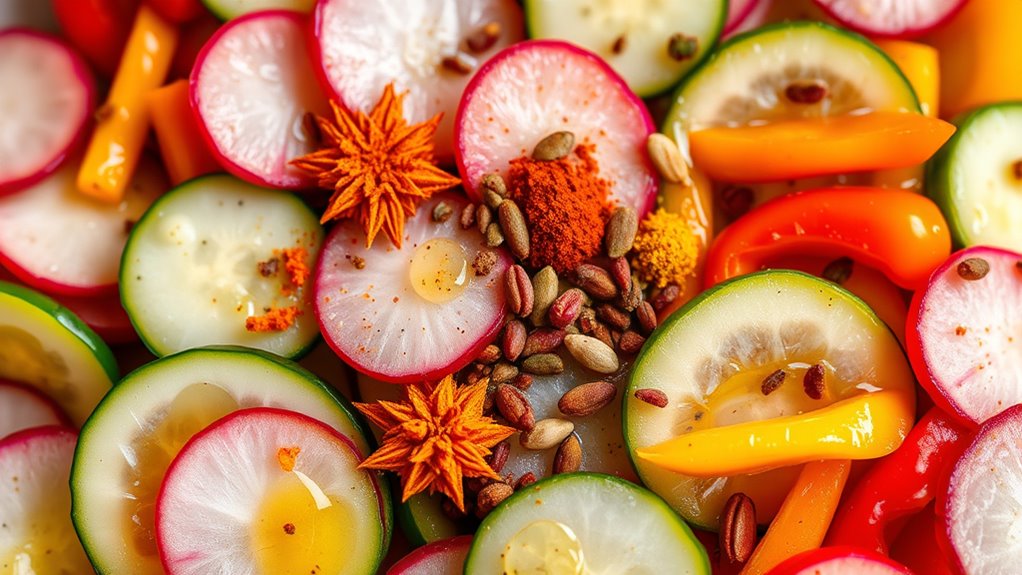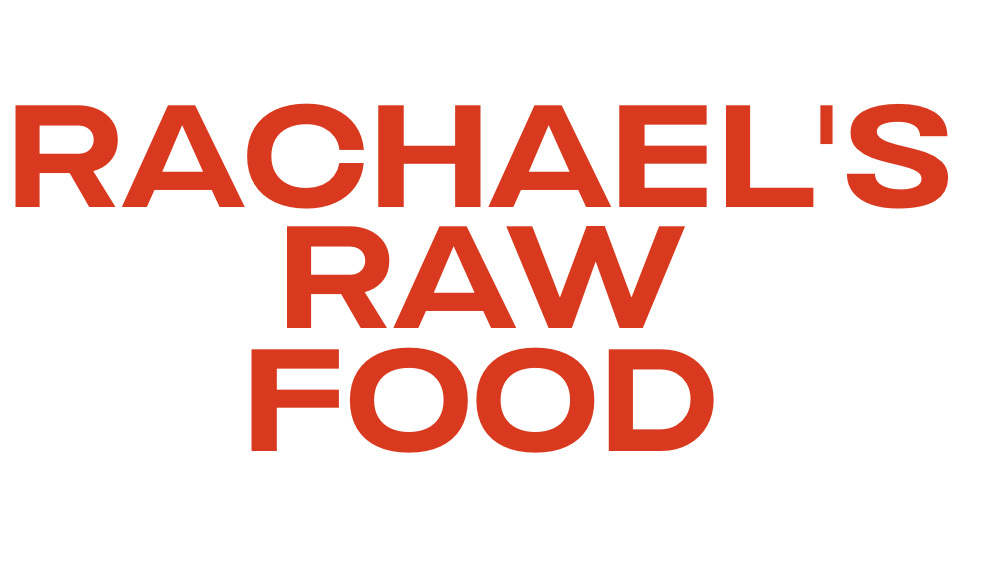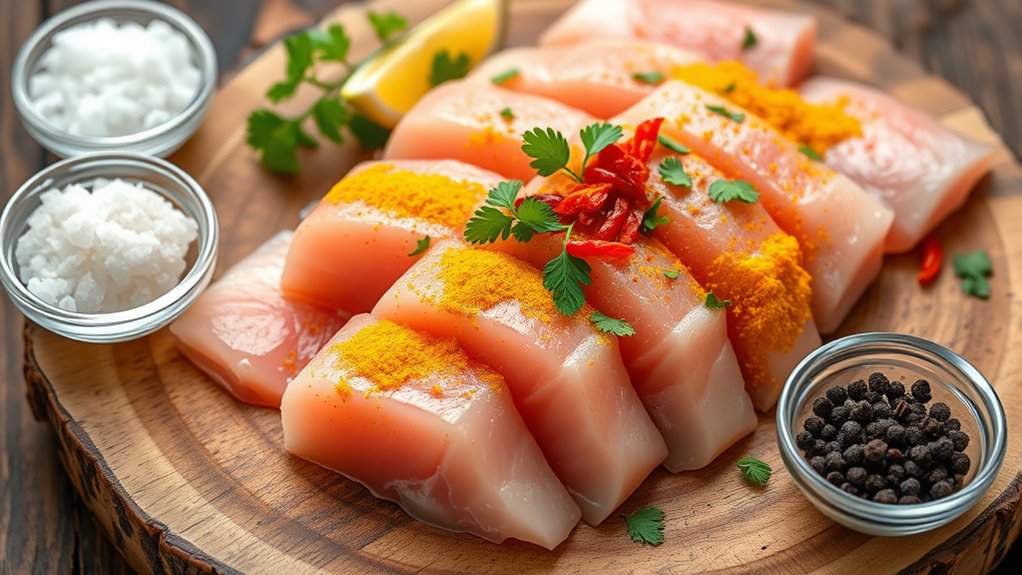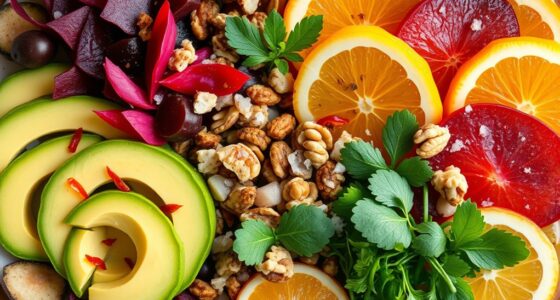To elevate raw dishes, pair fresh herbs like cilantro, basil, mint, and dill with spices such as black pepper, chili flakes, cumin, or smoked paprika to add depth and complexity. A splash of citrus like lemon or lime brightens flavors and balances spice heat, while carefully adjusting herb and spice quantities creates a harmonious profile. Incorporating these thoughtfully guarantees your raw creations remain light yet flavorful—discover more ways to perfect your dishes as you explore further.
Key Takeaways
- Incorporate citrus (lemon or lime) with spices like cumin or chili flakes to brighten and balance flavors.
- Use black pepper and chili flakes sparingly to add gentle heat without overpowering delicate raw ingredients.
- Combine smoked paprika with herbs like cilantro or basil for smoky, aromatic complexity.
- Pair warm spices such as cumin or a touch of cinnamon with fresh herbs to create depth and subtle warmth.
- Adjust spice levels gradually, ensuring they enhance rather than mask the natural freshness of raw dishes.

Raw dishes highlight fresh flavors, and choosing the right spices can elevate their taste even further. When you’re preparing raw creations like salads, ceviches, or tartares, the key is to enhance those natural ingredients without overpowering them. This is where herb combinations and flavor balancing come into play. By thoughtfully blending herbs and spices, you can create a harmonious profile that highlights freshness while adding complexity and depth. The goal is to find that perfect equilibrium where each element complements the others, resulting in a dish that’s vibrant and satisfying.
Start by experimenting with herb combinations such as cilantro, basil, mint, and dill. These herbs bring distinct notes—cilantro adds brightness, basil offers a sweet aroma, mint lends a cooling effect, and dill provides a subtle earthiness. When you combine them wisely, you create a layered flavor experience that enhances raw dishes without masking the ingredients’ natural qualities. Remember, balance is critical. Too much of one herb can dominate, so taste as you go and adjust accordingly. The idea is to create a subtle symphony of flavors that make each bite more interesting.
In addition to herbs, consider the role of spices in flavor balancing. A pinch of black pepper can add just enough heat to awaken the palate, while a dash of cumin introduces a warm, nutty undertone that complements fresh fish or vegetables. Lemon or lime juice also plays a fundamental role by cutting through richness and brightening flavors, acting as a natural counterpoint to the spices. When you integrate these elements, you’re not just adding flavor—you’re creating a nuanced profile that excites the senses.
Think about textures and temperature, too. Spices like chili flakes or smoked paprika can add a smoky or fiery kick, giving your raw dish more character. Use them sparingly to avoid overwhelming the delicate nature of raw ingredients. Combining herbs and spices thoughtfully allows you to craft a balanced dish where each component enhances the others. It’s all about flavor balancing—making sure no single element dominates, but instead, works in harmony to elevate the dish.
Ultimately, the art of spice pairing in raw dishes is about taste precision. You want to highlight the freshness while adding just enough spice and herbs to create complexity. With practice, you’ll develop an instinct for mixing herb combinations and balancing flavors, turning simple raw ingredients into extraordinary culinary experiences. Incorporating Glycolic Acid benefits can also improve skin health, which is important when preparing dishes that involve fresh ingredients and personal care.
Frequently Asked Questions
Can Spice Pairings Enhance the Nutritional Value of Raw Dishes?
Yes, spice pairings can enhance the nutritional value of raw dishes by adding antioxidant and anti-inflammatory properties. They also promote digestion, helping your body absorb nutrients more effectively. Plus, spices amplify flavors, making raw foods more appealing without extra calories. When you incorporate ingredients like turmeric or cumin, you’re boosting nutritional enhancement while elevating the overall flavor profile, creating a more satisfying and healthful eating experience.
Are There Spice Combinations Suitable for Sensitive Stomachs?
Think of your stomach as a delicate garden needing gentle care. You can use soothing herbs like basil or mint, and gentle spices such as cumin or coriander, which are less likely to cause discomfort. These combinations act like a calming rain, nourishing your garden without overwhelming it. Stick to mild, known-to-be-tolerant options, and you’ll enjoy flavorful raw dishes that soothe rather than upset your sensitive stomach.
How Do Spice Pairings Vary for Different Raw Cuisine Styles?
You’ll find that spice pairings vary greatly across raw cuisine styles due to cultural influences and regional flavor profiles. For example, Asian raw dishes often feature ginger, garlic, and sesame, while Latin-inspired raw dishes might include cumin, chili, and lime. By understanding these regional nuances, you can enhance your dishes authentically, balancing flavors and respecting culinary traditions, making each raw creation uniquely delicious and culturally rich.
Can Spice Pairings Be Adjusted for Personal Spice Tolerance?
Yes, you can absolutely adjust spice pairings to match your personal spice preferences. To do this, start with small, manageable amounts of heat and taste as you go. Whether you prefer mild or fiery flavors, adjusting spice heat is easy—simply add more or less of the spicy ingredients. By personalizing your spice pairings, you create a customized culinary experience that’s perfectly pleasing and perfectly tailored to you.
What Are Some Common Mistakes to Avoid in Spicing Raw Dishes?
Avoid over seasoning raw dishes, as it can overpower delicate flavors and create an unbalanced taste. Be cautious of incompatible spice blends, which can clash and ruin the dish’s harmony. Always taste as you go to prevent over seasoning pitfalls. Remember, less is often more with raw foods, so start with small amounts and adjust gradually. This way, you’ll enhance your dish without risking overpowering or flavor conflicts.
Conclusion
Think of spices as the brushstrokes that transform raw dishes into vibrant artwork. Each pairing adds depth and sparkle, like sunlight dancing across a still lake. When you choose your spices thoughtfully, you’re not just seasoning—you’re painting a story on your plate. Embrace these flavors as your palette, and let your raw creations shine with the subtle magic of well-chosen spice pairings, turning simple ingredients into a masterpiece.










